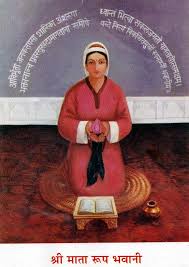Mata
Rupa Bhawani (c. 1621- c. 1721 birth name: Alakheshwar, also known
as Sharika Ansha Roopa) was a Kashmiri mystic poet. She
was a 17th-century Hindu saint who lived in present-day Kashmir.
She was the daughter of Pandit Madhav Joo Dhar, a
resident of Khankah-i-Shokta, Safa Kadal, Srinagar in the early 17th century.
He introduced her to the practices of yoga.
Oral and written
legend has it that Madhav Joo Dhar was an ardent devotee of Mata Sharika (Kali's).
He visited her temple daily at Hari Parvat to pray for hours. In
1620, on the first day of Navratra, pleased by his devotion, Mata Sharika
gave him a boon. Madhav Joo Dhar asked for a daughter, and Alakheshwar was born
to Joo's wife on Poorna Amavasya in the month of Jeth (Jyeshta) in 1621. The
exact year of her birth varies in a different account between 1620 and 1624.
Alakheshwar followed her father in pursuit of God and spirituality.
Rupa Bhawani's descendants, from her
paternal side, called Sahibi Dhars, have carried her message and memory
forward. They have been observing her nirvaan ceremony with great piety and
devotion at Safa Kadal, the place where she was born and also attained nirvaan,
and at Waskura in Baramulla district which the graced for many years after the
initial tapasya at Khanqahi Sokhta, Wusan near Ganderbal, Manigam in the same
area, and Chashma-i-Sahibi, adjacent to the renowed Chashma-i-Shahi on Zabarwan
hills in Srinagar district.
Brought up with affection, and
respect, Rupa Bhawani was married to a learned youngman, Pandit Hiranand Sapru,
at an early age with great pomp and show.
Even after her
marriage at an early age, she often visited Hari Parvat to perform her Sadhana at
midnight. This raised questions about her, as a woman out on her own. Her
mother-in-law and husband mistreated her. Roopa Bhawani was, however forced to forsake
Grihast as her in-laws, including Pandit Hiranand, could not reconcile to her
spiritual bent of mind and the meditative spells she had got used to at her
father's abode. Ultimately,
she left her in-law's house in the pursuit of God.
Alakheshwar performed
her Sadhana in solitude at Cheshma Shahi, Manigam and Vaskura.
These places, including her birthplace at Safa Kadal, are now famous as Ropa
Bhawani Asthapanas.
The First
Miracle
Her estrangement with the in-laws
accentuated after a miracle which her mother-in-law failed to comprehend. It is
recorded that at a special yagnya performed at the Sapru's place, the kulguru
of Dhar's could somehow not give a satisfactory account of his capabilities.
Not that he was not learned, but the other Brahmins present made fun of him. He
could not put up with this. Feeling humiliated, he wanted to leave unnoticed
without partaking of the prashad. And that is why and how the Mata's first
miracle took place. While the kulguru was trying to get away, he was accosted
by Rupa Bhawani. She requested him not to go away like that. "It is not
appropriate to go away without taking food" she told him adding "you,
Sir, seem to be very tired. Why don't you have a bath in the river (Vitasta)
and feel fresh and then take food?" The kulguru could not refuse. He had
the bath as advised, and while coming back he was accosted againg by Rupa
Bhawani. She gave him a full glance, welcoming him to the dinner. This glance
transformed lhe Brahmin into a well-versed and confident guru. Bowing to the
Bhawani, he partook of the food, and after that recited a full poem in praise
of the Mother spontaneously, winning applause from one and all, including those
who had tried to humiliate him only a few hours earlier.
This miracle of the Bhawani
invited strong reaction. Her mother-in-law got infuriated, she provoked her son
and made it impossbile for Rupa Bhawani to live in her house. And this brought
about the Sanyas of the Mata. She returned to her father's place, bared her
heart to him. Consoled and encouraged by the father Rupa Bhawani started her
meditation in right earnest. However, finding regular meditation somewhat
difficult in a grahast, she shifted to Wusan, Manigam, Waskura, Chashma-
i-Sahibi, etc. in that order, creating ashrams at every spot holding spititual
discourses, attracting devotees, Hindus and Muslims alike, and performing
miracles. A real sanyasin, she was the mother to all irrespective of caste or
creed.
The great old chinar tree on the
bank of Sindh river in Manigam, the culmination of a half-burnt branch planted
by the Mata with her bsnign hands was, till some year back, standing as a mute
but living witness to her spirituality. A devastating fire in Manigam was
extinguished by her through a mere glance. Fish cooked for Shivaratri in the
house of Pandit Lal Chand in Manigam started crawling over to the wall when it
was learnt that the fish had been cooked in spite of her presence in the house.
A potter's son got his eyesight back on completing the digging of a well at
Waskura at her bidding. A shankh-shaped spring in Chashma-i-Sahibi appeared in
the Zabarwan hill area when Rupa Bhawani shifted there, giving the hillock its
name.
Mahanirvaan
Mata Rupa Bhawani attained
mahanirvaan at her father's place, where she spent her last days. It was the
Saptami of Magha Krishna Pakshya in Samvat 1777. The day is since known as
Sahib Saptami, observed by all the Hindus in Kashmir.
Websites:

No comments:
Post a Comment